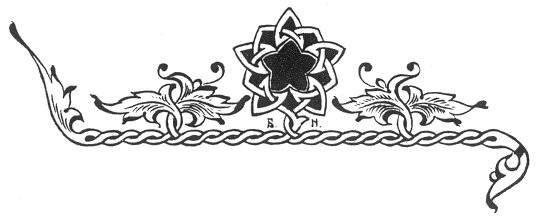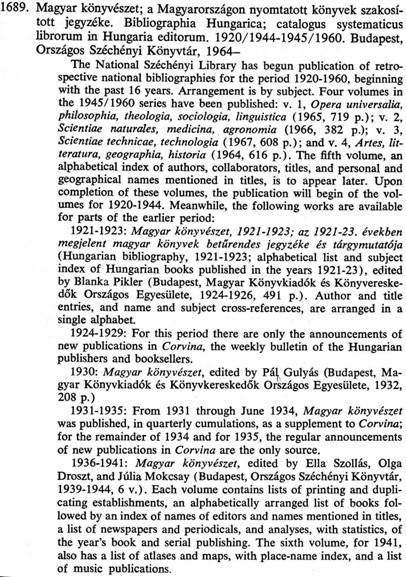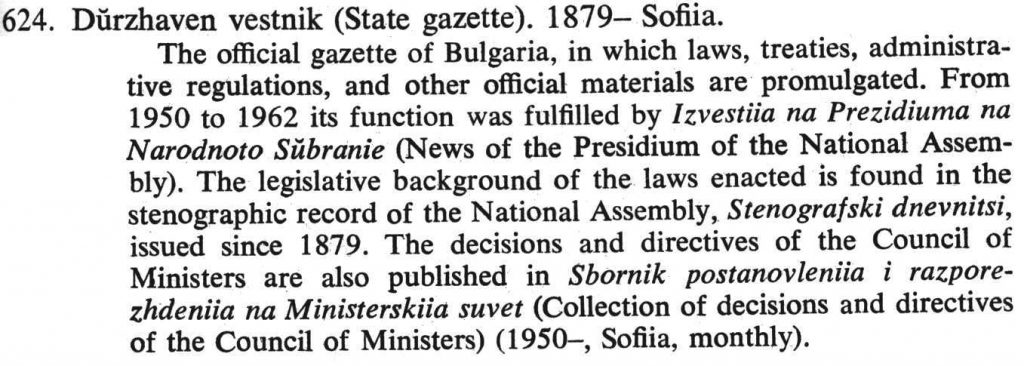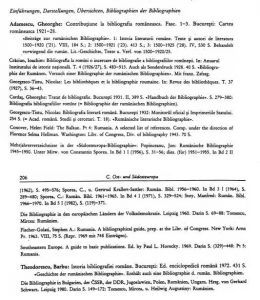General Resources

Bibliographien zum Schrifttum aus und uber Osteuropa.
Bruhn, Peter and Volkhard Thiede, (Series: Bibliographische Mitteilungen des Osteuropa-Instituts an der Freien Universitat Berlin.27) Munchen:Omnia Mikrofilmtechnik GmbH. 1992
U of I Library Call Number: International & Area Studies General Slavic Reference (Slavic) F.015.47F 882b
This excellent catalog provides access to many of the bibliographic resources for the region. The catalog lists those materials available at the institute and is limited only by the contents of that institution’s library. The catalog is organized by country and then subdivided into subject headings.
Each regional section contains copies of the card catalog cards for specific bibliographies. There are extensive sections on national bibliography and retrospective bibliography for each country. This is a very rich source for the beginning scholar seeking an overview of the bibliographic coverage for a particular topic. The catalog covers all bibliographies on a region and topic and is not limited by language.
A note on organization may be helpful. The table of contents is entirely in German and can make it somewhat difficult to find some of the material in this catalog. Further, the entries themselves reflect all the changes library catalogs have experienced over the years. Therefore, some have complete author-title entries. Others will be limited to title and call number. As with some of the other sources, this catalog requires a careful reading if it is to be used effectively. The lack of annotations is a handicap.
![]()
Slavic studies: a guide to bibliographies, encyclopedias, and handbooks.
Croucher, Murlin (ed.), Wilmington: Scholarly Resources Inc. 1993.
U of I Library Call Number: International & Area Studies General Slavic Reference (Slavic) and Main Stacks Q.016.947 Sl16 V.1-2
 Croucher’s two volume work on Slavic studies is an excellent overall guide to resources in the Slavic field. He includes not only bibliographic titles, but reference resources of all types. The work is organized by country with a general section entitled “Area Studies” opening the first volume. Each section is preceded by a listing of the organizational headings used in that section. All entries include complete bibliographic information as well as Indiana’s classification number, the Library of Congress number is included in brackets in some cases. Occasionally, other holding institutions will be listed. The compiler did not include electronic resources in this volume.
Croucher’s two volume work on Slavic studies is an excellent overall guide to resources in the Slavic field. He includes not only bibliographic titles, but reference resources of all types. The work is organized by country with a general section entitled “Area Studies” opening the first volume. Each section is preceded by a listing of the organizational headings used in that section. All entries include complete bibliographic information as well as Indiana’s classification number, the Library of Congress number is included in brackets in some cases. Occasionally, other holding institutions will be listed. The compiler did not include electronic resources in this volume.
For the less experienced scholar, this source requires a bit more finesse for several reasons. While it is extremely thorough, listing thousands of sources, the subject headings are somewhat idiosyncratic.
Thus, the entry for Estreicher’s monumental bibliography of Polish publications is not under the entry “Bibliography” as the user might expect, but rather under “Imprints”.
 The annotations frequently do not indicate the significance of the source as in the case of that given for Estreicher’s work.
The annotations frequently do not indicate the significance of the source as in the case of that given for Estreicher’s work.
By contrast the entry for the Czech bibliography by Foit Cesky katalog bibliograficky za rok 1889-1903 (Slavic studies, V.1, p. 197) is extensive with more detail.
The annotations for the two sources would certainly not indicate the significance of the source. The Czech source covers a 14 year time span while Estreicher’s work spans several centuries. The issue here is how an uninitiated user might interpret the very cursory annotation for the Polish source. However, if you are familiar with the sources in a general way, and are seeking a list of bibliographic entries on a particular subject it can be an excellent resource.
Slavic studies is a wonderful resource but does require some expertise on the part of the user.
![]()
Encyclopedia of world cultures.
Levinson, David, ed. New York: G. K. Hall & Co., 1991-. V.1-10.
V.6 Russia and Eurasia/China
U of I Library Call Number: Q.306 En19 International & Area Studies General Slavic Reference (Slavic) and Social Science, Health & Education Reference (Volumes 1-10)
This work is described in general as follows: “A basic reference source to the cultures of the world. Provides descriptions of all the cultures of each region of the world or of a representative sample of cultures for regions where full coverage is impossible, as well as accurate descriptions of cultures of the past.”
The volume is arranged alphabetically by culture. The editors have included a general orientation section for each culture as well as information on the history, settlements, economy, kinship structure, family structure, sociopolitical organization and religion of each people. This information is followed by a brief bibliography of major sources, in the vernacular language and English. This is a useful introductory source and can be helpful in orienting oneself to the major bibliographic sources for a particular ethnographic group.
Each volume includes a glossary of terms and a filmography. There is also an “Ethnonym Index” which can be useful in finding alternative names of various ethnographic groups.
![]()
East Central Europe. A guide to basic publications.
Horecky, Paul L., Chicago: The University of Chicago Press, 1969. 956p.
U of I Library Call Number: International & Area Studies General Slavic Reference (Slavic), Oak Street Facility, and Main Stacks Reference 016.943 H78e; Undergrad Z2438 .H56 1969
 One of a series of guides on Eastern Europe published in the late 1960s, this remains an excellent starting point to obtain a basic knowledge of sources on the region. The volume is organized mainly by country, but does have a general section at the beginning which lists sources on the region. It includes Czechoslovakia, East Germany, Hungary, Poland, Sorbians and Polabians.
One of a series of guides on Eastern Europe published in the late 1960s, this remains an excellent starting point to obtain a basic knowledge of sources on the region. The volume is organized mainly by country, but does have a general section at the beginning which lists sources on the region. It includes Czechoslovakia, East Germany, Hungary, Poland, Sorbians and Polabians.
Horecky’s stated purpose was to select the most important sources on the region. Within each regional division he has subsections devoted to individual topics: general reference, bibliographies, the land, the people, history, the state, economy, society, intellectual and cultural life. It is also important to keep in mind that the editors have been very selective and never intended for this to serve as a comprehensive source.
One of the features that makes this such a rich source of information is the extensive annotation that is supplied for the major sources. Horecky relied on a group of scholars to select and annotate the sources in this volume. Their subject expertise is apparent in every entry.
This is a source that is only useful for those looking at retrospective material since it has never been updated. However, it is a source one frequently returns too for an overview of the publishing within a particular subject area. It also provides a sense of the interest in certain topics at various times. The annotations are rich in detail providing a wealth of supplemental material. They are a wonderful source for information on the national bibliographic material for the country, legal publications, general reference publications such as encyclopedias, biographical sources, statistics, periodical publications and many other topics. Citations listed in the annotations are included in the main index. Another virtue of this title is that is widely held and can be found in most libraries.
![]()
Southeastern Europe. A guide to basic publications.
Horecky, Paul L., Chicago: The University of Chicago Press, 1969. 755p.
U of I Library Call Number: International & Area Studies General Slavic Reference (Slavic), Oak Street Facility, and Main Stacks Reference 016.91496 H78s; Undergraduate Z2831 .H67 1969
Like the volume on East Central Europe this volume was compiled with the assistance of a number of specialists. The volume is organized by country with one general section on the region. The countries included are Albania, Bulgaria, Greece, Romania, Yugoslavia.
 Horecky’s stated purpose was to select the most important sources on the region. Within each regional division he has subsections devoted to individual topics: general reference, bibliographies, the land, the people, history, the state, economy, society, intellectual and cultural life. It is also important to keep in mind that the editors have been very selective and never intended for this to serve as a comprehensive source.
Horecky’s stated purpose was to select the most important sources on the region. Within each regional division he has subsections devoted to individual topics: general reference, bibliographies, the land, the people, history, the state, economy, society, intellectual and cultural life. It is also important to keep in mind that the editors have been very selective and never intended for this to serve as a comprehensive source.
One of the features that makes this such a rich source of information is the extensive annotation that is supplied for the major sources. Horecky relied on a group of scholars to select and annotate the sources in this volume. Their subject expertise is apparent in every entry. Many of these contain valuable clues to tracking material in a particular country on a specific topic. For example, legal materials are frequently difficult to identify. The entries in this volume provide useful information for anyone seeking to track legal information as is apparent in the following citation.
As should be clear from the citation, the compiler has provided more than just information on this title. The information on supporting publications is extremely valuable. This is typical of Horecky’s guide. It is a feature that sets them apart from other publications that may be more comprehensive, but less informative for the novice. The rich annotations make this source especially valuable for general information on bibliography, general reference sources, legal information, periodicals and their indexes, dictionaries, statistical sources and a number of other topics.
![]()
Internet legal resource guide
URL: www.ilrg.com
The Internet legal resource guide is one of the most useful sources on the web for identifying a wide range of materials on law. The site is organized around its search mechanism. From the page pictured above, the user would select a country from a list on the bottom of the page. The user then selects one of four categories from a pull-down menu. These include all sites, commercial sites, educational sites, government sites, organization sites. The user can do a search on any term and get a list of matches for that country. It is a useful mechanism for locating current information on law for all countries.
This is primarily a search mechanism and not a subject listing.
![]()
Bibliography of Slavic dictionaries.
Lewanski, Richard C., Bologna:Editrice Compositori, 1972, V.1-4. (Part of World Bibliography of Dictionaries.)
U of I Library Call Number: International & Area Studies General Slavic Reference (Slavic) 016.4918 L58b 1972 V.1-4
This is a source with a variety of uses. The most obvious is as a reference guide to the published dictionaries for the region. The four volumes are arranged by country, beginning with volume one devoted completely to Poland. The dictionaries included are not just language resources. Lewanski has included biographical dictionaries, encyclopedias, dictionaries, thus it provides access to a number of different types of sources.
The first volume on Poland was intended as a single study Polish language dictionaries. The coverage of this language is, to some extent more complete than those represented in the other volumes. Volume two is devoted to general Slavic dictionaries, Belorussian, Bulgarian, Czech, Kashubian, Lusatian, Polabian, Macedonian, Old Church Slavic, Serbocroatian, Slovak, Slovenian, and Ukrainian. Each section is followed by its own author, language and subject index. Volume three is devoted to Russian and the final volume updates the sources in the previous three volumes.
Lewanski’s set is a very good starting point. However, the scholar should be aware that the absence of any annotation makes it difficult to find some of the more valuable resources. A case in point is the Slovar’ sovremennogo russkogo literaturnogo iazyka published by the Academy of Sciences. This is a valuable resource for identifying quotations, as well as tracing the origins of terms to their original literary usage. Using Lewanski effectively presupposes at least a basic knowledge of the sources.
![]()
Virtual library history central catalogue
URL: http://vlib.iue.it/history/index.html
This is an excellent resource for those seeking electronic information on history for all regions. The links on the page are divided into the following categories: research methods and materials, historical topics, eras and epochs, regions. From these sites the user can find most Western gateway sites for specific topics. The site is hosted by the University of Kansas and is kept current by its numerous editors.
The majority of the sites listed here are in English. However, most have listings of vernacular language materials, for example, Marshall Poe’s site on Russian History. It is a useful clearinghouse for electronic resources on the history and should not be overlooked.
![]()
Guide to Hungarian studies.
Bako, Elemer, Stanford: Hoover Institution Press, 1973. Vol. 1-2.
U of I Library Call Number: International & Area Studies Hungarian Reference (Slavic) 016.91439 B17g v.1-2; Main Stacks A.940.91L53b no.52
Bako’s excellent discussion of the resources for Hungarian studies is essential to anyone beginning work in this field. While it is almost 30 years out of date, it still provides the most convenient and thorough coverage of the sources available in all areas of study on Hungary.
The volume is much more than just a bibliography containing a chronology of Hungarian history and a discussion of the origins of Hungarian culture. Bako has included all areas of research with sections on culture, general resources, statistics, geography, geology, demography, folklore, ethnology, history, government, politics, society, economics, religion, language, literature, fine arts, education, science, press and Hungarica.
The interdisciplinary nature of this work makes it especially useful for anyone interested in Hungarian studies. The section on general works is a survey of many of the most important resources for the region. including such titles as The American bibliography of Slavic and East European studies. Some of the more noticeable omissions include Horecky and Horak’s bibliographies. However, Bako notes in his introduction that he does not attempt to be comprehensive. His annotations are very brief when any are included.
![]()
Guide to reference books. (11th edition).
Balay, Robert (ed.), Chicago:American Library Association. 1996.
U of I Library Call Number: 025.51 W721G Main Reference
This guide was published in many editions. It is divided by subject category and will give a quick overview of reference sources in all areas of study. Some country sections will be subdivided into sections on bibliography, history, guides, encyclopedias, translations, biography, etc. This is the case for the section on Russian literature. For other countries all entries will be under the general subject area with no subdivision, e.g. Polish literature. All entries are annotated, providing basic information on the content of the source and its publication history. The work includes an index that interfiles authors, editors, compilers, titles and subjects in one alphabet. The compiler has drawn on earlier editions and works published since the earlier editions appeared. As the compiler notes, the guide is intended for a North American audience and emphasizes sources published in and relevant to that region of the world. However, it does provide an introduction to foreign sources.
It is not comprehensive and for some topics will only give the briefest of indications of the sources available on a subject. Thus, to have a thorough knowledge of the sources will require a great deal more work. However, it is an excellent starting point. It is the type of source that is enormously useful when beginning work on a topic that is unfamiliar. It is widely available and can be found in virtually all libraries.
![]()
Bibliographie der nationalen bibliographien.
 Domay, Freidrich, Stuttgart: Anton Hiersemann-Verlag. 1987
Domay, Freidrich, Stuttgart: Anton Hiersemann-Verlag. 1987
U of I Library Call Number: International & Area Studies General Slavic Reference (Slavic) and Library & Information Science 016.015 D711b c.2
The rather lengthy entry you see below is included to illustrate the wealth of material included in this guide to national bibliography.
For those seeking information on the national bibliographies of the nations of the world this is one of the best sources. The compiler has divided the volume into sections by continent and country. For each country his includes information on national bibliography in the broadest sense. That is, he includes annotated citations not only for the official national bibliographic publications of each country, but for all those publications that provided a record of the press in that nation. He also has no chronological limit.
He further assists the researcher by including information on a wide range of sources on the bibliography of each nation. Thus, under Romania, Domay includes a section entitled “Einfuhrungen, Darstellungen, Ubersichten, Bibliographien der Bibliographien” which includes a list of sources that will serve the scholar in finding a range of material on Romania.
Information sources in law.
Winterton, Jules and Moys, Elizabeth M., London: Bowker Saur. 1997.
U of I Library Call Number: International & Area Studies General Slavic Reference (Slavic) 016.3494 In37 1997
This is a guide to current legal publications for all of Europe. The goal was to provide a guide to current sources on the subject for each country. Each section is written by an expert and all bear a similar arrangement, although there are different selection criteria for the material cited. “However, the overall objective is constant; that of providing a way into a subject to those new to the field or to identify major new or possibly unexplored sources to those already familiar with it.”(p.v)
The volume is arranged by country. Within each country section there is an introduction on the legal system in that nation, a discussion of legal research in the area, with sources for texts of legislation, codes and commentaries, treaties, and law reports. There is also a discussion with references to online access to legal codes. The authors includes information on legal encyclopedias, bibliographies and dictionaries that the researcher should be aware of. There is a listing of serial publications and statistical resources as well.
Each section closes with a bibliography of works cited. The opening section covers general works on the field and directs the researcher to a number of useful, but often overlooked resources. For example, one of the sources mentioned under directories is The World of Learning. This is a directory of institutions of higher education. The authors here also note its usefulness in identifying libraries and scholarly associations. All in all this is an excellent resource for anyone working on current legal research in the region.

